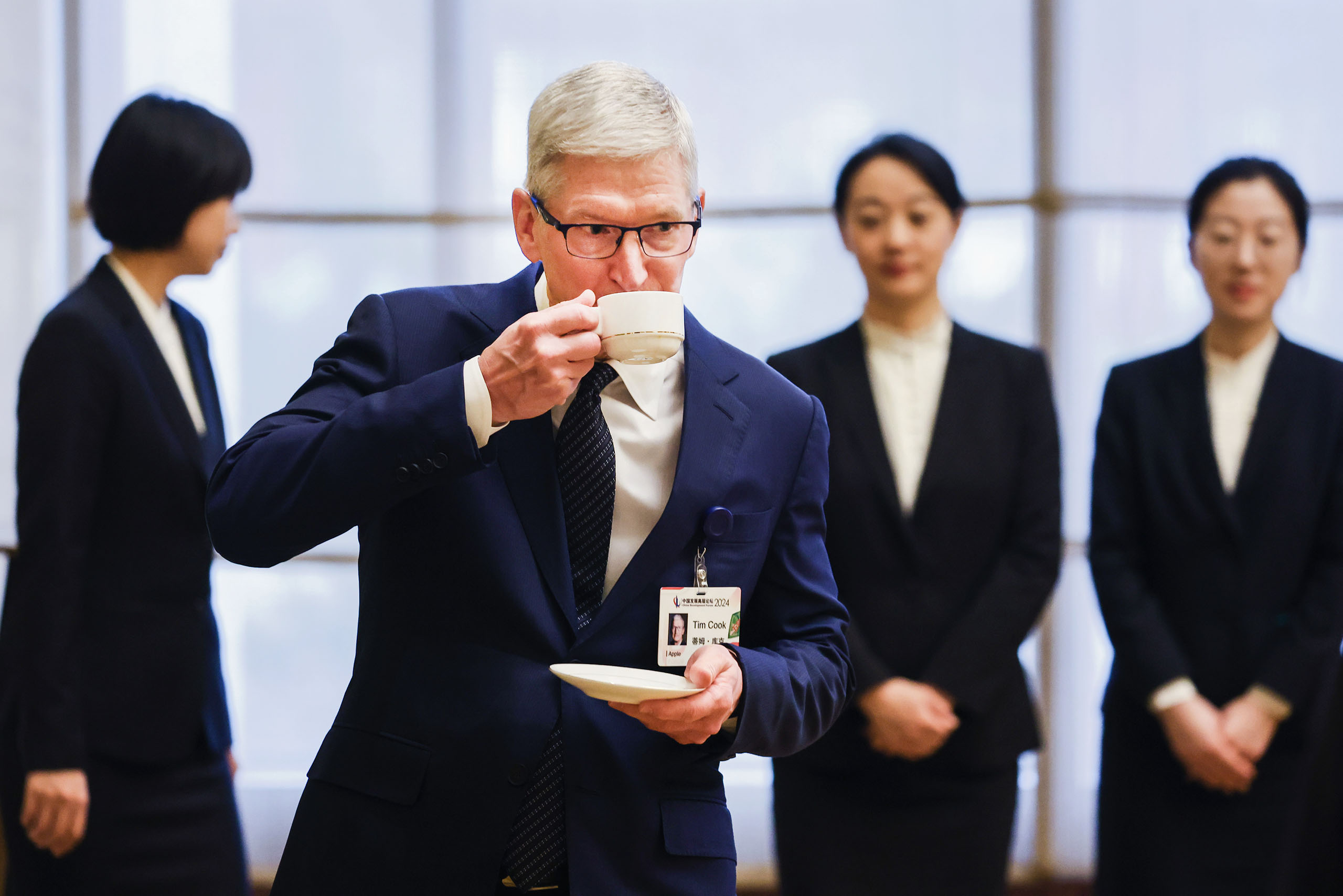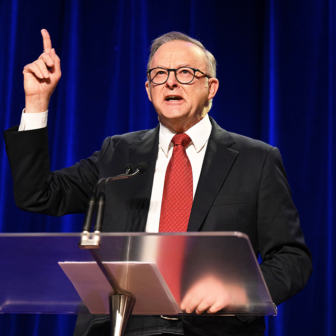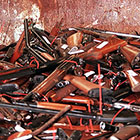It doesn’t matter that Washington and Beijing have reached an inconclusive and temporary truce in Mr Trump’s trade war. The US president immediately claimed it as a win, but that only underlines the fundamental problem for the Trump administration and America: a shortsighted focus on inconsequential skirmishes as the larger war with China is being decisively lost.
— Kyle Chan, New York Times, 19 May 2025
Apple, the world’s leading manufacturer, epitomises the futility of the US–China tariff wars. Having sailed close to the financial wind in its first iteration, Apple Computer Company (founded by two Steves: Jobs and Wozniak), it became a poster child for American innovation, product excellence and financial muscle in its second life, as Apple Inc. (under Jobs alone). Yet Apple is very much Chinese.
Patrick McGee’s revealing new book Apple in China traces the company’s progress from near bankruptcy in the 1990s to legendary status. This is an account of how it was done — a story of the symbiotic relationship between Apple’s obsessive urge to turn impossible design ideas into products and an eager Chinese appetite for industrial knowledge and skills.
That was not the plan. Jobs wanted Apple to be an end-to-end manufacturer, building or buying up the capability to solve its unique design demands and creating its own unique components. Yet, as McGee shows, the company’s success — the amazing impact of its designs and products — drove it away from in-house manufacturing and away from the United States. As late as 2000, Jobs had been talking about Apple’s “Mac-tories,” and in 2010 he was still pushing a wholesome image of Apple’s approach. “We create our own A4 chip, our own software, our own battery chemistry, our own enclosure, our own everything,” he told an investor briefing. “We engineer so much of it ourselves. The A4 chip inside it is an Apple creation… We develop a lot of our own components.” But note the active words: create, engineer, develop. Missing: the word make.
Meanwhile, in China, a once-small Taiwanese contract manufacturer had built a series of secure campuses housing more than a million workers. Terry Guo’s Foxconn (then Hon Hai Plastics) had started in a Taiwan shed about two years before Apple Computers emerged from a California garage in 1976. Guo won his first major contract from Apple in 1999, at which time his company had reached an annual $US1.8 billion in revenue. By 2010 the figure was $US98 billion.
Apple became a self-sufficient, highly skilled company because of its remarkable ability to turn complex and challenging ideas into products. The fact that it did so at enormous scale was one factor in its profitability. The fact that it could bring new products to market quickly and consistently was another. But the key ingredient went largely unnoticed.
Japanese and Taiwanese contract manufacturers had been central to the ability of IBM, and later Dell and Compaq and many other companies, to deliver personal computers at low cost. Apple’s early inability to do so had contributed to its near failure. So when Jobs had his second bite at Apple, he needed to avoid competing as yet another commodity — and he also had to overcome the scale-manufacturing challenge.
Jobs might have been tempted to pursue the “Mac-tories” he’d talked about in 2000. Struggling in a tough tech market, though, the company didn’t have the funds for a huge expansion of manufacturing. One of Jobs’s hires, former senior IBM and Compaq figure Tim Cook, had tried to convince him that outsourcing was the answer. Jobs demurred… and then he didn’t.
McGee paints a vivid image of Cook as a relentless, process-driven stickler — and a superb negotiator. But Jobs and Apple weren’t aiming simply for low costs. They required a perfect product: a function not only of quality control but also of the capacity to devise the means for making things that were otherwise figments of designers’ imaginations.
Terry Guo had already flipped the script for contract manufacturers by offering incentives to his clients to allow him to make more than just the commodity element of products. He had often absorbed the cost of tooling — an expensive upfront expense in manufacturing — to get a bigger share of the going jobs and ultimately control the whole vertical process.
He had also learned to tap the desire of China’s bureaucrats for new industry. Gradually after 1978 and more rapidly after 1992, Shenzhen (where Guo had established himself) had become a hub for Chinese industry. Like many Hong Kong manufacturers shifting into the Pearl River delta, he brought the expertise and local government had organised financial support, land, buildings and labour.
When Apple came to Foxconn, the ostensible goals of the two seemed incompatible. Apple wanted to make unproven designs — and make them at massive scale. While contract manufacturers typically aim to minimise capital costs and compete intensely on cost, Guo was chasing opportunities to move Foxconn out of that shark pool.
Sold at premium prices, Apple products came to account for 20 per cent of global sales in its markets, with an amazing 80 per cent share of global profits, most of which was due to its highly evolved manufacturing network. Foxconn’s income grew massively, but Cook’s relentlessness reduced Foxconn’s profit margin year after year.
But this wasn’t a one-way street: Apple flew hundreds of engineers to China to train Foxconn employees and work with them to develop manufacturing solutions to meet apparently impossible specifications. As time went on, Apple cemented its influence by providing expensive equipment and machinery, some of it unique. McGee cites Apple investments of tens of billions of dollars as the company consolidated what once was a series of global hubs — Singapore, Ireland and California — into a huge China operation.
After a period of uncertainty — notably during the dotcom period — Apple’s momentum became remarkable. In 2011, the year of Steve Jobs’s death, revenue almost doubled to just under $US90 billion. Under Cook’s leadership the disruption of its creative inspiration’s death passed quickly, with 2013 revenues almost doubling the 2011 number.
In the meantime, though, a much more serious challenge had emerged. In November 2012, just over a year after Jobs’s death, Xi Jinping was appointed general secretary of the Communist Party of China. His elevation marked a sharp change of direction from the relatively loose, “collective” leadership that had emerged after Deng Xiaoping’s death in 1997.
Xi quickly tightened the reins of power and initiated an anti-corruption campaign that took down “tigers” (senior figures) as well as “flies,” including party officials who might have contested his leadership. His posture and rhetoric emphasised two “core” interests: the primacy of the Communist Party and the need for firm leadership. At one stage publicly humiliating his predecessor, Hu Jintao, Xi set out to tackle the weak leadership and corruption that had prevailed under his predecessors, who had fostered foreign investment by companies like Apple.
Within months of his ascension, Xi spoke forcefully in closed party forums about the inevitable failure of capitalism and the ultimate triumph of socialism. Publicly, he promoted the “China Dream” and the values of hard work and nationalism.
Apple had its first taste of Xi’s emerging agenda on “consumer day” in March 2013 when state-owned broadcaster CCTV berated Apple for its “incomparable” arrogance. In response to the chilling atmosphere, Apple set about creating a “team of eight” senior executives to focus on China. But its initial, clumsy responses plainly reflected the ease with which it had established a sophisticated global manufacturing base employing controversial labour practices and substantial local government support despite having little high-level awareness of Chinese politics.
China’s political reset primarily aimed to assert the central authority of the Communist Party. With cronyism and corruption having become a threat to the party’s status, Xi’s disciplinary measures ranged widely, eventually capturing even ministers he himself had appointed. One early shock was a series of moves against prominent technology companies, including sharp action against Alibaba, an e-commerce conglomerate, and its founder Jack Ma. Just as his fintech was about to list in New York, Ma openly criticised the Chinese banking system. Chinese regulators canned the listing and Ma dropped from sight.
From around 2015, foreign companies, including many that had operated in China for decades, noticed a change in their local interactions. Government agencies became wary and even local Chinese staff were communicating in ways that confused headquarters management. Xi was taking on two extremely difficult challenges at once: reining in a rampant growth in debt, which had fuelled a massive property and construction boom, and shifting the focus of policy away from labour-based cost competition and towards higher value Chinese industry, notably in renewables, electric vehicles and biotech.
A new national strategic plan and industrial policy, Made in China 2025, was announced by premier Li Keqiang in May 2015. Its aim was to fuel higher productivity and higher-value industries. China no longer wanted to be an outsource partner for foreign giants; under Xi it would have its own leading global industry companies.
Apple faced a variety of dilemmas during this period. Fundamentally, it was insufficiently Chinese — it wasn’t a joint venture and it had been careless in some of its dealings — which was directly at odds with the Xi ethos. When it came, Apple’s response was remarkably effective — and revealing. It was able to demonstrate that China had benefited more from its approach than it would have if Apple had involved a local partner.
More than once, McGee says Apple was probably the largest single contributor to the goals of Made in China 2025. In its pitch to the government, it put a huge number on the table: $US55 billion in investment each year. On top of its capital investments, it argued that a large part of its massive wage bill was spent training local workers to meet the demands of its rapid product cycle, which entailed constant new setups. The company was also willing to let its local contractors supply other companies. McGee says the 1600 factories in Apple’s network effectively gave Chinese smartphone manufacturers the means to develop products and effectively put others, like Nokia, out of business.
The most striking benefit of Apple’s appeal to Beijing came in the form of something that didn’t happen. Stifled by security policies in a variety of countries, China’s national telecoms champion, Huawei, turned to smartphone manufacturing and quickly ruined Apple’s market in China for lower-value phones while also chewing off a big slice of its premium Chinese buyers. After Huawei was denied access to the United States, though, its rival phone offering lost ground rapidly.
Huawei is central to Xi’s technology plans, so it would have been unsurprising had Beijing taken retaliatory action against Apple. But none came. McGee sums it up this way: “Politically, Cook’s move was a masterstroke. Apple survived a trade war between the United States and China by gaining exemptions on tariffs from the Trump administration. And even though Washington kneecapped Huawei, Beijing didn’t retaliate, because Cook had already made it clear just how much Apple was investing in the country, raising quality standards across its electronics supply chain.”
Apple has continued its relentless growth, increasingly through paid services delivered to its billion-plus network of global users. Its China operations, diversified a little with small steps into Vietnam and India, remain its manufacturing hub — with one major change. Foxconn’s Taiwanese-owned network is now largely Chinese, McGee reports, with local companies having hired Foxconn expertise or, in some cases, bought out the companies.
Looking ahead, McGee positions Apple as a metaphor. “Intel co-founder Andy Grove had warned that without manufacturing, America might lose the ability to innovate. Certainly that was the case for any number of hardware companies that sent blueprints off to Asia for someone else to turn into gleaming products. In Apple’s case, Grove’s worry was only partially true, but in revealing ways. Apple still knew how to manufacture; the problem was that it couldn’t execute these plans without China.”
Apple in China corrects an imbalance in the vast library of Apple analysis. By detailing the inherently symbiotic rise of Apple and China’s remarkable manufacturing capability, it exposes a fundamental misunderstanding in the US–China trade wars. Apple taught itself (and everyone else) to think of China as a place where its products were “assembled,” the easy implication being that its Chinese partners were adding little value as government-backed suppliers of low-cost labour. It’s not a big step from that misreading to Trump’s trade wars, which Apple told investors in May would impose $US900 million in US import tariffs on the company each quarter.
McGee makes it clear that tariffs won’t force Apple to bring its manufacturing back on shore. The company tried to do that in Trump’s first term but Texas Instruments, despite being US-based, was producing parts overseas, testing the parts overseas, and then bringing them into America.
Apple’s appeal to Xi Jinping rested in large part on the idea that expertise — in this case the ability to create complete manufactures — is critical infrastructure. As Intel’s Andy Grove said fifteen years ago, when the US lost its focus on manufacturing it didn’t lose jobs. It lost the ability to bring innovations to scale at home. Effectively, it lost control of its technology.
Under Xi, China is struggling with the financial baggage of past errors and burdened by strict political discipline. Yet the Made in China 2025 agenda is, if anything, accelerating — and producing signs of indigenous innovation. It has the enormous advantage of a very large domestic market, providing the party can find the political will to promote domestic consumption. Trump’s America wants to restore manufacturing capability, but has elected a leader who thinks this is purely an act of revenge. •
Apple in China: The Capture of the World’s Greatest Company
By Patrick McGee | Simon & Schuster | $36.99 | 448 pages




